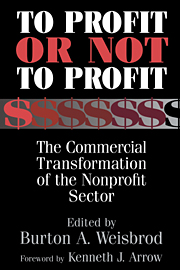Book contents
- Frontmatter
- Contents
- List of contributors
- Foreword by Kenneth J. Arrow
- Preface
- 1 The nonprofit mission and its financing: Growing links between nonprofits and the rest of the economy
- Part I Basic issues and perspective
- Part II Industry studies
- 8 Commercialism in nonprofit hospitals
- 9 Universities as creators and retailers of intellectual property: Life-sciences research and commercial development
- 10 Commercialism in nonprofit social service associations: Its character, significance, and rationale
- 11 Zoos and aquariums
- 12 Commerce and the muse: Are art museums becoming commercial?
- 13 The funding perils of the Corporation for Public Broadcasting
- Part III Overview, conclusions, and public-policy issues
- Appendix: IRS Forms 990 and 990-T for nonprofit organizations
- References
- Index
10 - Commercialism in nonprofit social service associations: Its character, significance, and rationale
Published online by Cambridge University Press: 30 November 2009
- Frontmatter
- Contents
- List of contributors
- Foreword by Kenneth J. Arrow
- Preface
- 1 The nonprofit mission and its financing: Growing links between nonprofits and the rest of the economy
- Part I Basic issues and perspective
- Part II Industry studies
- 8 Commercialism in nonprofit hospitals
- 9 Universities as creators and retailers of intellectual property: Life-sciences research and commercial development
- 10 Commercialism in nonprofit social service associations: Its character, significance, and rationale
- 11 Zoos and aquariums
- 12 Commerce and the muse: Are art museums becoming commercial?
- 13 The funding perils of the Corporation for Public Broadcasting
- Part III Overview, conclusions, and public-policy issues
- Appendix: IRS Forms 990 and 990-T for nonprofit organizations
- References
- Index
Summary
Introduction
Overall, income from sales of services now constitutes the largest and fastest-growing source of revenues for private, nonprofit organizations in the United States, proportionally larger than charitable contributions or income from governmental sources. Salamon (1992) estimates that fees and charges constituted some 51 percent of total gross income of nonprofit public-benefit organizations in 1989, and that such income accounted for 55 percent of the growth in nonprofit revenues between 1977 and 1989. Although reliance on income from sales varies widely among subsectors, there is little doubt that these trends are now pervasive throughout the U.S. nonprofit sector.
This chapter investigates the nature of this development in selected segments of the social services subsector – in six national, social service “umbrella” associations encompassing youth services, health charities, and services for older Americans, as well as among affiliates of a seventh association in the field of community and recreational services. First, a conceptual framework is established that relates commercial income to the missions of nonprofit organizations and to changes in their economic environments. Second, the variety and magnitude of commercial income sources, and the strategic issues associated with these sources, are described through case studies of the six national associations. Third, the commercial income of affiliates of the Jewish Community Centers (JCC) Association is statistically analyzed to determine its relation to other income sources, including external grants and contributions and membership fees, and to financial performance.
- Type
- Chapter
- Information
- To Profit or Not to ProfitThe Commercial Transformation of the Nonprofit Sector, pp. 195 - 216Publisher: Cambridge University PressPrint publication year: 1998
- 17
- Cited by



